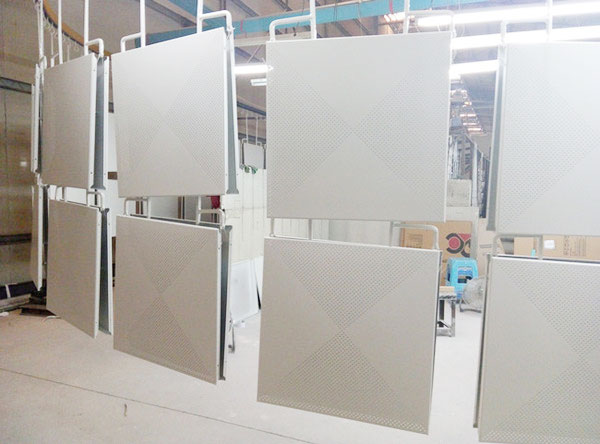production
Production of Aluminum Ceiling
Aluminum Ceiling is a new type of decorative material that has emerged in recent years. Roll-coated aluminum ceilings are made of standard aluminum hot-rolled aluminum alloy plates starting with 3003/3105 as the base material, and laminated through the three-coating and three-baking rolling process. It has the characteristics of light weight, water resistance, no dust absorption, corrosion resistance, easy scrubbing, easy installation, strong three-dimensional effect, soft color and elegant appearance, etc., and is well received by users.

Aluminum Ceiling production process:
1. Material slitting: The raw material is generally the color-coated aluminum coil produced by Henan Chalco, with a width ranging from 1240 to 1300mm, and the total amount is about 3 tons. The coil should be slit longitudinally, then sliced transversely, and processed The blank of square aluminum ceiling;
2.leveling: the blanks drawn from the coil will be a little uneven and arc-shaped. Each piece of material should be leveled with a leveling machine, and then sent to the subsequent process;
3. Punching: Some aluminum ceiling materials have punching requirements, which need to be completed with special mechanical equipment. If punching is not required, this process can be omitted;
4. Cut corners: Before forming, cut the 4 corners according to the drawing, otherwise it will not be formed. The size of the cut corners is designed, and the corners should be cut in place when cutting, otherwise the angle between the board and the board when the ceiling is hoisted Will be uneven
5. Forming: Send the blank to the hydraulic press, and use the mold to press and form;
6. Edge trimming: The ceiling pressed by Aluminum Ceiling hydraulic press will inevitably bounce back due to the characteristics of the metal. At this time, the angle between the edge of the ceiling and the plane is greater than 90°, which will cause difficulties in assembly. The solution is to Add an edge punching process, use a punch with a die to punch the inner angle of each edge and the plane to less than 88°;
7. Cloth: The aluminum ceiling that has been punched also needs to be pasted with dust-proof and sound-absorbing cloth;
8. Drying: The patch uses glue and needs to be dried or air-dried;
9. Inspection: Finished product inspection should check the paint quality, flatness and dimensional error. Use 8 samples to hoist every other batch into a small piece to check if there is any problem with the assembly effect;
10. Packing: Pack the aluminum ceiling materials that have completed all the processes. Note that the edges of the aluminum ceiling materials will scratch other boards or vibrate and rub during transportation, and scratch the paint.

Advantages of aluminum ceiling process:
1. Roll-coated aluminum ceilings are healthy and environmentally friendly, using standard aluminum as the base material, without free chromium, tribute and other harmful metal elements, in line with EU standards;
2. The roll-coated aluminum ceiling adopts advanced nanotechnology, which is resistant to scratches, corrosion and oil;
3. Roll-coated aluminum ceiling is resistant to decay: the color is durable and not easy to change color;
4. Roll-coated aluminum ceiling is acid and alkali resistant;
5. Roll-coated aluminum ceilings are resistant to chalking, and the process of roll coating is uniform and delicate, which can effectively avoid chalking of the ceiling surface.







